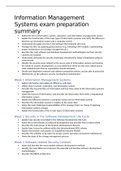Samenvatting
Haal je studiepunten voor Information Management Systems met déze samenvatting
- Instelling
- Saxion Hogeschool (Saxion)
De handouts van Makri gebruikt voor het schrijven van de samenvatting. Alle leerdoelen per week zijn nagegaan en inbegrepen in de samenvatting, dus alle stof die je moet kennen voor het (her)tentamen zit in dit document, beknopt, maar wel allesomvattend! Kwartiel 3.4 van de studie Security Manageme...
[Meer zien]





